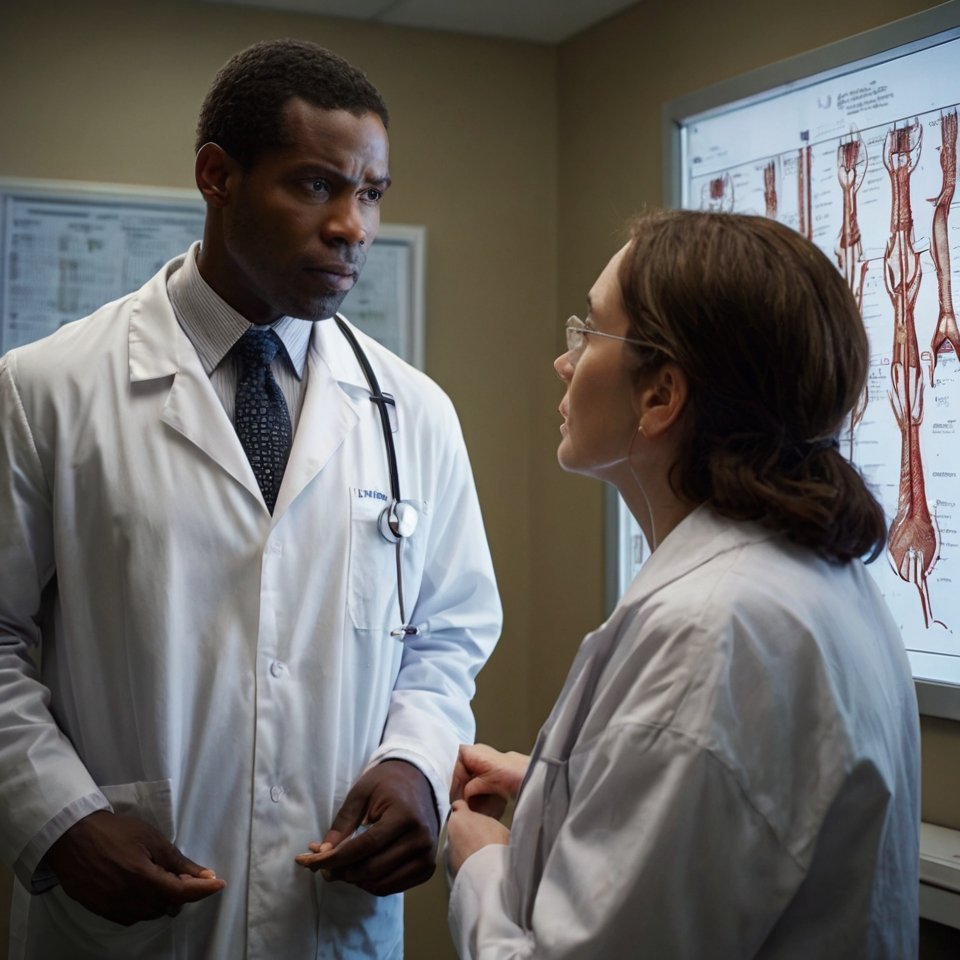Liver Cancer 101: What You Need to Know About Symptoms, Treatment & Prevention

Facing Liver Cancer? Here’s How to Take Control of Your Health & Treatment
Your liver is one of the hardest-working organs in your body. It processes everything you eat and drink, detoxifies harmful substances, and keeps things running smoothly—yet most people don’t think about it until something goes wrong.
And when something does go wrong, it can be serious.
Liver cancer often develops quietly, without obvious symptoms in the early stages.
By the time most people notice something is wrong—fatigue that won’t go away, unexplained weight loss, persistent stomach pain—the disease has already advanced. Learn the common early signs of liver cancer to catch it before it progresses too far.
The problem? Liver cancer is one of the deadliest cancers worldwide.
It’s often caught late, making treatment harder and significantly lowering survival rates. That’s why early detection impacts survival so dramatically.
So why aren’t we talking about it more?
Let’s change that. Whether you’re here because you or a loved one have been diagnosed, or you just want to understand how to protect yourself, this guide will break it all down—what causes liver cancer, how to detect it early, and what you can do to fight it.
What Are the First Signs of Liver Cancer? Recognizing the Symptoms Before It’s Too Late
Liver cancer doesn’t throw a big, dramatic entrance like some other illnesses. It sneaks in quietly, often showing no symptoms at all in the early stages. That’s why it’s usually discovered accidentally—during routine blood work or scans for an unrelated issue.
But as the disease progresses, your body starts sending signals—subtle at first, then impossible to ignore. Some of these symptoms overlap with digestive symptoms that overlap with colon cancer, making it even harder to spot early. Here’s what to watch for:
- Unexplained weight loss – If the number on the scale is dropping and you haven’t changed your diet or exercise habits, something deeper might be going on.
- Persistent fatigue – Not the “I need more coffee” kind, but the bone-deep exhaustion that won’t go away, no matter how much rest you get.
- Loss of appetite – When your go-to meals suddenly don’t sound appealing, it could be a red flag.
- Abdominal pain or swelling – A dull ache or discomfort in the upper right side of your belly might indicate liver trouble.
- Jaundice (Yellowing of the Skin and Eyes) – One of the most recognizable signs that your liver isn’t doing its job properly.
- Dark urine and pale stools – Your liver plays a huge role in digestion, and when it’s compromised, it shows in your bathroom habits.

Why Early Detection is Crucial
Because liver cancer symptoms often mimic other less serious conditions, it’s easy to dismiss them—until it’s too late. If you experience any of these signs for more than a few weeks, it’s time to see a doctor. That’s true for warning signs of cancer you shouldn’t ignore across many different cancer types.
It’s helpful to understand how liver and lung symptoms compare so you can spot potential warning signs early.
So, what’s causing this silent killer in the first place? Let’s talk about the risk factors next.
What Causes Liver Cancer? Understanding the Risk Factors
Liver cancer doesn’t just happen out of nowhere. It usually develops over time, thanks to a mix of lifestyle choices, underlying health conditions, and even genetics. While some risk factors are beyond your control, many are preventable—which means understanding them can help you take action before it’s too late. Learn how liver health impacts cancer development.

The Biggest Risk Factors for Liver Cancer
- Chronic Hepatitis B or C Infections – These viral infections silently damage the liver for years, increasing the risk of liver cancer by up to 100 times. (Hepatitis B is vaccine-preventable, but hepatitis C has no vaccine—just treatment.)
- Cirrhosis – A scarred liver doesn’t function well, and over time, it raises the risk of liver cancer significantly. Cirrhosis can be caused by chronic alcohol use, viral hepatitis, or non-alcoholic fatty liver disease (NAFLD).
- Alcohol Abuse – Long-term heavy drinking inflames and scars the liver, setting the stage for cirrhosis and liver cancer.
- Non-Alcoholic Fatty Liver Disease (NAFLD) – A growing problem worldwide, NAFLD is linked to obesity, diabetes, and metabolic syndrome. It can quietly damage the liver, just like alcohol—but without the drinking.
- Aflatoxin Exposure – Found in moldy peanuts, corn, and grains, aflatoxins are carcinogenic toxins that increase the risk of liver cancer, especially in regions with poor food storage practices.
- Diabetes and Obesity – Excess body fat leads to inflammation, insulin resistance, and fatty liver disease, all of which can fuel liver cancer development.
- Genetics – If a close family member has had liver cancer, your risk may be higher.
Who’s Most at Risk?
If you have multiple risk factors, your chances of developing liver cancer increase. For example:
- A person with chronic hepatitis C and a history of alcohol use has a significantly higher risk than someone with just one of these factors.
- An overweight person with type 2 diabetes and fatty liver disease may not drink alcohol at all but still have an elevated risk.
The Good News? You Can Lower Your Risk
While you can’t change your genetics, you can take steps to reduce many other risks—starting with screening, lifestyle changes, and vaccinations.
Next, let’s talk about how liver cancer is diagnosed and what tests are used to catch it early.
How is Liver Cancer Diagnosed? The Tests You Need to Know
Liver cancer is tricky—it doesn’t always make itself known until it’s already advanced. That’s why early detection is critical. If you’re at high risk (due to hepatitis, cirrhosis, or other factors), regular screenings could save your life.
So, how do doctors catch liver cancer before it’s too late?

Key Tests for Liver Cancer Diagnosis
Blood Tests (AFP Test)
- Doctors check for alpha-fetoprotein (AFP)—a protein that sometimes spikes in liver cancer patients.
- Not foolproof: Some people with liver cancer have normal AFP levels, and some without cancer have high levels. Read more about cancer blood tests and how they work.
Imaging Scans (Seeing the Cancer Before It Spreads)
- Ultrasound – The first-line screening tool, often used for high-risk patients.
- CT Scan (Computed Tomography) – Provides detailed images of liver tumors and helps determine cancer stage.
- MRI (Magnetic Resonance Imaging) – Gives even more precise details, especially about blood vessel involvement.
Liver Biopsy (When More Answers Are Needed)
- If scans are inconclusive, a doctor may take a small tissue sample from the liver to confirm cancer.
- Not always required—if imaging clearly shows liver cancer, a biopsy may not be needed.
Liver Function Tests (How Well is Your Liver Working?)
- Measures enzymes and proteins to check for liver damage or disease progression.
Who Should Get Screened for Liver Cancer?
If you fall into any of these categories, doctors recommend screening every 6 months:
✅ People with chronic hepatitis B or C
✅ Those with cirrhosis (regardless of the cause)
✅ Individuals with a family history of liver cancer
✅ People with severe fatty liver disease (NAFLD/NASH)
Why Early Detection is Everything
Liver cancer found in early stages can often be treated successfully with surgery or targeted therapies. But if it’s caught too late, survival rates drop significantly.
This is why screening matters—even if you feel fine.
Now that we know how liver cancer is diagnosed, let’s look at stages of the disease and what they mean for treatment.
Liver Cancer Stages: What Do They Mean for Treatment?
Hearing the words “You have liver cancer” is terrifying—but the next question is just as important: What stage is it?
Liver cancer staging helps doctors determine the best treatment plan and predict outcomes. The earlier the stage, the more treatment options you have.
The Four Stages of Liver Cancer
Stage 0 (Very Early Stage)
- Tumor is smaller than 2 cm
- No blood vessel involvement
- Liver function is still normal
- Treatment Options: Surgery or ablation therapy (both highly effective at this stage)
- Survival Rate: 70–90% after treatment

Stage 1 (Early Stage)
- A single tumor, but it may be larger than 2 cm
- No spread to blood vessels or other organs
- Treatment Options: Liver resection (surgery) or transplant
- Survival Rate: Around 50–70%
Stage 2 (Intermediate Stage)
- One tumor with blood vessel involvement OR multiple small tumors
- Liver function is still relatively normal
- Treatment Options: Localized therapies like radiofrequency ablation (RFA) or targeted treatments
- Survival Rate: Around 30–50%
Stage 3 (Advanced Stage)
- Large tumor invading major blood vessels OR multiple large tumors
- May have spread to nearby lymph nodes
- Treatment Options: Targeted therapies, immunotherapy, or radiation (surgery is rarely an option)
- Survival Rate: Around 10–20%
Stage 4 (End-Stage, Metastatic Liver Cancer)
- Cancer has spread beyond the liver (lungs, bones, or other organs)
- Treatment Options: Palliative care to manage symptoms, clinical trials for experimental treatments
- Survival Rate: Less than 10%
Stage 4 liver cancer is often metastatic—learn how liver cancer can spread and what that means for treatment planning.
The stage not only determines treatment—it also affects your odds of recovery. Learn about the survival rate by liver cancer stage to better understand your outlook.

Why Staging Matters
Knowing the stage of liver cancer helps guide treatment decisions. While early-stage liver cancer is often curable, later stages require more aggressive therapies to slow progression and manage symptoms.
Next, let’s explore the best treatment options and whether liver cancer is curable.
Is Liver Cancer Curable? Treatment Options Explained
The moment you hear the words “liver cancer,” one question dominates your thoughts: “Is it curable?”
The answer depends on the stage at diagnosis, overall liver health, and available treatment options. Early-stage liver cancer can often be completely removed or controlled, while advanced cases require aggressive treatments to slow progression. Learn more about what treatment options mean for your future and how they can shape your outcome.
Curative Treatment Options (Best for Early-Stage Liver Cancer)
✅ Liver Resection (Surgery to Remove the Tumor)
- Best for: Stage 0 or 1 patients with a single tumor and good liver function.
- What it does: Removes the cancerous part of the liver while leaving the healthy portion intact.
- Survival Rates: 50–70% five-year survival if cancer is caught early.
✅ Liver Transplant (Replacing the Entire Liver)
- Best for: Patients with cirrhosis or small, localized liver tumors.
- What it does: Replaces the diseased liver with a healthy donor liver.
- Survival Rates: 70–90% five-year survival if the transplant is successful.
- The challenge? Finding a donor. The waiting list for liver transplants is long.
Non-Surgical Treatments (For Advanced Liver Cancer or Inoperable Cases)
🟡 Ablation Therapy (Destroying Tumors Without Surgery)
- Methods: Radiofrequency ablation (RFA), microwave ablation (MWA), or cryoablation.
- Used when: Surgery isn’t an option, but the tumors are small.
🟡 Targeted Drug Therapy (Cutting Off the Cancer’s Lifeline)
- Drugs like Sorafenib (Nexavar) and Lenvatinib (Lenvima) block cancer growth by cutting off its blood supply.
- Used for Stage 3 and 4 patients to slow progression.
🟡 Immunotherapy (Training Your Body to Fight Back)
- Drugs like Atezolizumab (Tecentriq) + Bevacizumab (Avastin) help the immune system recognize and attack cancer cells.
- Can extend survival in advanced cases.
🟡 Radiation Therapy (Shrinking Tumors & Relieving Symptoms)
- Often used when surgery isn’t possible or to shrink tumors before another treatment.
🟡 Chemotherapy (Used When Other Treatments Fail)
- Not the first choice for liver cancer because the liver filters drugs quickly, making chemo less effective.
- Typically used in combination with other treatments.
So, Can Liver Cancer Be Cured?
- YES → If caught early (Stage 0 or 1) and treated with surgery or transplant.
- MAYBE → If in intermediate stages, treatments can control it for years.
- NO (but manageable) → If it has spread, the goal shifts to slowing the disease, reducing symptoms, and extending life.
Next, let’s talk about survival rates and what they mean for liver cancer patients.
Liver Cancer Survival Rates: What You Need to Know
When faced with a liver cancer diagnosis, one of the first questions people ask is: “How long do I have?”
While it’s a tough question, survival rates provide a general idea of what to expect based on past cases. However, remember—these are statistics, not personal predictions. Many people outlive survival estimates, especially with new treatments and early detection.

Survival Rates by Liver Cancer Stage
Survival rates are typically measured in five-year survival percentages, meaning the percentage of people still alive five years after diagnosis.
| Liver Cancer Stage | Five-Year Survival Rate |
|---|---|
| Localized (Stages 0 & 1) | 35–70% (Best outcome with surgery or transplant) |
| Regional (Stage 2 & 3 – Tumor has spread to nearby organs or lymph nodes) | 10–30% |
| Distant (Stage 4 – Cancer has spread beyond the liver) | 2–10% |
➡ Localized liver cancer has the best chance for long-term survival, especially with surgical removal or liver transplant.
➡ Once the cancer spreads beyond the liver, survival rates drop significantly, but immunotherapy and targeted treatments are improving outcomes.
Want to compare survival stats across different cancers? Prostate, breast, and colon cancer each have unique outlooks based on stage and treatment approach.

What Affects Survival Rates?
Several factors influence how long someone with liver cancer may live:
- Early Detection: The sooner it’s found, the better the odds.
- Overall Liver Health: If you have cirrhosis or hepatitis, it complicates treatment.
- Treatment Success: A successful surgery or liver transplant dramatically improves survival chances.
- Response to Therapy: Some patients respond well to targeted drugs and immunotherapy, extending life expectancy.
What This Means for You
Liver cancer isn’t always a death sentence. Early diagnosis + the right treatment = better outcomes. If you’re at risk, regular screenings could mean the difference between catching cancer at Stage 1 (treatable) versus Stage 4 (limited options).
Next, let’s talk about prevention—because liver cancer is one of the most preventable cancers out there.
Can Liver Cancer Be Prevented? Tips for Reducing Your Risk
Liver cancer is one of the deadliest cancers—but here’s the good news: it’s also one of the most preventable. Unlike some cancers that seem to strike at random, liver cancer is usually the result of long-term damage to the liver—and that damage can often be avoided.
Want to lower your risk? Here’s how:
1. Get Vaccinated Against Hepatitis B
- Hepatitis B is a major cause of liver cancer—but there’s a vaccine for it.
- If you haven’t been vaccinated, talk to your doctor about getting it ASAP.
2. Avoid Hepatitis C (Since There’s No Vaccine for It)
- Hepatitis C is a silent killer—many people don’t know they have it until their liver is already damaged.
- How to prevent it:
✅ Avoid sharing needles (even for tattoos or piercings).
✅ Practice safe sex.
✅ Get tested if you were born between 1945-1965 (Baby Boomers are at higher risk).
3. Limit Alcohol and Stop Smoking
- Excess alcohol consumption scars the liver (cirrhosis), increasing the risk of liver cancer.
- Smoking introduces toxins that make cancer more likely—so if you smoke, quitting is one of the best things you can do.
4. Maintain a Healthy Weight & Control Diabetes
- Obesity and type 2 diabetes can cause non-alcoholic fatty liver disease (NAFLD), which increases liver cancer risk.
- Ways to manage weight & diabetes:
✅ Eat a balanced diet (diet and liver support for prevention)
✅ Stay active—just 30 minutes a day can help.
✅ Keep blood sugar levels in check.
Much like with colon cancer, gut health and lifestyle changes can make a major impact on lowering your liver cancer risk.
5. Avoid Aflatoxins in Food
- Aflatoxins are toxic molds found in improperly stored grains, nuts, and corn—especially in warm, humid regions.
- Buy fresh, properly stored nuts and grains, and don’t eat moldy foods.
6. Regular Liver Screenings if You’re High Risk
- If you have cirrhosis, hepatitis, or a family history of liver cancer, get screened every 6 months.
- Early detection dramatically improves survival rates.
Bottom Line: Prevention Starts with You
Liver cancer may be deadly, but it’s not inevitable. Protect your liver today, and you could be saving your life tomorrow.
Next up: The best foods to eat (and avoid) to keep your liver healthy.
Best Diet for Liver Cancer Prevention and Management
Your liver is your body’s detox powerhouse, filtering out toxins and breaking down everything you eat. But what if your diet is actually working against your liver instead of supporting it?
Whether you’re trying to prevent liver cancer or manage your health after a diagnosis, what you eat matters. Explore diet and cancer prevention strategies proven to support recovery and lower risk. A liver-friendly diet can reduce inflammation, support liver function, and even lower your risk of cancer progression.
Best Foods for Liver Health
✅ Leafy Greens & Cruciferous Vegetables
- Spinach, kale, broccoli, and Brussels sprouts help flush out toxins and support liver detox.
- Broccoli contains sulforaphane, a compound linked to lower cancer risk.

✅ Fatty Fish & Omega-3s
- Salmon, sardines, and walnuts contain anti-inflammatory omega-3s that protect liver cells.
- Omega-3s help fight fatty liver disease, which is a major risk factor for liver cancer.
✅ Berries (Blueberries, Cranberries, Raspberries)
- Packed with antioxidants that neutralize free radicals and reduce liver inflammation.
✅ Turmeric & Green Tea
- Turmeric (Curcumin): Has powerful anti-cancer properties and helps the liver break down toxins.
- Green Tea: Contains catechins, compounds that protect liver cells from damage.
✅ Garlic & Nuts
- Garlic activates liver detox enzymes that remove harmful substances.
- Nuts (almonds, walnuts, Brazil nuts) provide healthy fats and vitamin E, which support liver repair.

Foods to Avoid (They’re Hard on Your Liver!)
❌ Alcohol – Even in small amounts, alcohol damages liver cells and can accelerate disease progression.
❌ Processed & Fried Foods – High in trans fats, which contribute to fatty liver and inflammation.
❌ Sugary Drinks & Refined Carbs – Soda, white bread, and pastries spike blood sugar, increasing fat buildup in the liver.
❌ Red & Processed Meat – Linked to higher risks of liver disease and cancer, especially if eaten in excess.
How Diet Can Reduce Liver Cancer Risk
Eating a plant-based, anti-inflammatory diet helps:
✔ Reduce liver fat buildup (which can lead to cirrhosis and cancer).
✔ Lower inflammation, a key driver of tumor growth.
✔ Provide essential nutrients to support healthy liver function.
Your Liver Loves Healthy Choices
You don’t need to overhaul your diet overnight, but small changes add up. Choose whole, nutrient-dense foods, and your liver will thank you for it.
Next, let’s talk about how fast liver cancer spreads and what to expect after a diagnosis.
Visit our Contact Page and let us know how we can improve this guide
We’d love to hear from you!
